Spent a while tonight looking up the Battle for Thermopylae (as in the movie 300), read a lot about Spartans, and came across the term "Laconic". I had seen the word before, but really didn't understand it's meaning. Wiki defines it as "a very concise or terse statement". They go on to further define it with the word humor, as in "laconic humor" which together come out something like a very concise statement with an injection of dry wit.
Obviously the most famous of Laconic statements occurred at the Battle for Thermopylae, as the Persians asked for the Spartan's weapons, King Leonidas replied "Molon Labe" or "come and get them". But there are more laconic statements to be found, and some of them are quite memorable.
With key Greek city-states in submission, Philip II of Macedon turned his attention to Sparta and sent a message: "If I win this war, you will be slaves forever." In another version, Philip proclaims: "You are advised to submit without further delay, for if I bring my army into your land, I will destroy your farms, slay your people, and raze your city." The Spartan ephors sent back a one word reply: "If." Subsequently, both Philip and Alexander would avoid Sparta entirely.
Spartan mothers or wives gave a departing warrior his shield with the words "With it or on it!", implying that he should return (victoriously) with his shield, or (his cremated body in an urn) upon it, but by no means after saving himself by throwing away his heavy shield and fleeing.
During the era of westward expansion in the United States of America a group of thieves, bandits and outlaws began terrorizing a small community in the state of Texas, killing several citizens. The townsmen quickly requested help from the Texas Rangers. When Ranger Pat Dooling arrived, the townsmen could not believe that only one man had been sent. In response to their question about the arrival of other Rangers, Dooling famously responded "You've only got one riot, haven't you?"
American President Calvin Coolidge had a reputation in private of being a man of few words and was nicknamed "Silent Cal." A possibly apocryphal story has it that Dorothy Parker, seated next to him at a dinner, said to him, "Mr. Coolidge, I've made a bet against a fellow who said it was impossible to get more than two words out of you." His reply: "You lose."
And (perhaps due to indoctrination) my favorite: During the Korean War, U.S. Marine Chesty Puller made the remark, "We've been looking for the enemy for some time now. We've finally found him. We're surrounded. That simplifies things."
and one that deserves honorable mention: During the French estrangement from NATO, Charles de Gaulle demanded that all American troops leave French soil. Lyndon B. Johnson is said to have responded, "Does that include the ones [buried] at Omaha Beach?"
Hope you enjoyed. Thanks to Wikipedia for the above quotes, and for allowing me to waste the better part of an evening reviewing 2500 year old history.
Obviously the most famous of Laconic statements occurred at the Battle for Thermopylae, as the Persians asked for the Spartan's weapons, King Leonidas replied "Molon Labe" or "come and get them". But there are more laconic statements to be found, and some of them are quite memorable.
With key Greek city-states in submission, Philip II of Macedon turned his attention to Sparta and sent a message: "If I win this war, you will be slaves forever." In another version, Philip proclaims: "You are advised to submit without further delay, for if I bring my army into your land, I will destroy your farms, slay your people, and raze your city." The Spartan ephors sent back a one word reply: "If." Subsequently, both Philip and Alexander would avoid Sparta entirely.
Spartan mothers or wives gave a departing warrior his shield with the words "With it or on it!", implying that he should return (victoriously) with his shield, or (his cremated body in an urn) upon it, but by no means after saving himself by throwing away his heavy shield and fleeing.
During the era of westward expansion in the United States of America a group of thieves, bandits and outlaws began terrorizing a small community in the state of Texas, killing several citizens. The townsmen quickly requested help from the Texas Rangers. When Ranger Pat Dooling arrived, the townsmen could not believe that only one man had been sent. In response to their question about the arrival of other Rangers, Dooling famously responded "You've only got one riot, haven't you?"
American President Calvin Coolidge had a reputation in private of being a man of few words and was nicknamed "Silent Cal." A possibly apocryphal story has it that Dorothy Parker, seated next to him at a dinner, said to him, "Mr. Coolidge, I've made a bet against a fellow who said it was impossible to get more than two words out of you." His reply: "You lose."
And (perhaps due to indoctrination) my favorite: During the Korean War, U.S. Marine Chesty Puller made the remark, "We've been looking for the enemy for some time now. We've finally found him. We're surrounded. That simplifies things."
and one that deserves honorable mention: During the French estrangement from NATO, Charles de Gaulle demanded that all American troops leave French soil. Lyndon B. Johnson is said to have responded, "Does that include the ones [buried] at Omaha Beach?"
Hope you enjoyed. Thanks to Wikipedia for the above quotes, and for allowing me to waste the better part of an evening reviewing 2500 year old history.

